Distinguished Military Unit: 442nd Infantry Regiment

The 442nd Infantry Regiment was constituted on June 4, 1942, as the 100th Infantry Battalion (Separate). It was activated on June 12, 1942, at Oakland, California, with personnel from the Hawaiian Provisional Infantry Battalion. "The 442nd Regimental Combat Team was organized on March 23, 1943. Within a month, 2,686 volunteers from Hawai'i and 1,500 from the U.S. mainland were in Camp Shelby, 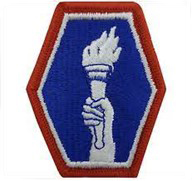 Mississippi, for basic training. The 442nd included three infantry battalions, the 522nd Field Artillery Battalion, the 232nd Combat Engineers Company, an Anti Tank Company, a Cannon Company, Medical Detachment, and the 206th Army Ground Forces Band. On May 1, 1944, the RCT, minus the 1st Battalion, left for Italy, where it joined the 100th Infantry Battalion just north of Rome. The 1st Battalion had been sending troops to replace the killed and wounded in the 100th, and its ranks were substantially depleted; the men still in the Battalion were reserved in place as training officers for the next group of volunteers at Shelby. The 442nd entered combat north of Rome in June 1944 when it incorporated the 100th Battalion, which, because of its outstanding combat record, was allowed to keep its designation. Thus, the infantry units in the RCT were the 100th, 2nd, and 3rd Battalions. The 442nd was attached to the 5th Army."
Mississippi, for basic training. The 442nd included three infantry battalions, the 522nd Field Artillery Battalion, the 232nd Combat Engineers Company, an Anti Tank Company, a Cannon Company, Medical Detachment, and the 206th Army Ground Forces Band. On May 1, 1944, the RCT, minus the 1st Battalion, left for Italy, where it joined the 100th Infantry Battalion just north of Rome. The 1st Battalion had been sending troops to replace the killed and wounded in the 100th, and its ranks were substantially depleted; the men still in the Battalion were reserved in place as training officers for the next group of volunteers at Shelby. The 442nd entered combat north of Rome in June 1944 when it incorporated the 100th Battalion, which, because of its outstanding combat record, was allowed to keep its designation. Thus, the infantry units in the RCT were the 100th, 2nd, and 3rd Battalions. The 442nd was attached to the 5th Army."
The regimental motto most often associated with the 442nd IR, "Go for Broke," as presented on the unit’s DUI, originated in slang used during gambling, perhaps especially in Craps, to denote going all in, "shooting the works," risking everything on one roll of dice in betting. It is not readily known who started the tradition in the regiment or if it was simply spontaneous. The phrase became something of a rallying cry amongst stateside Japanese in America as well during WWII, cheering on their team in battle despite government-imposed extreme deprivations being endured here at home. On February 19, 1942, FDR issued Executive Order 9066, which led to the forced relocation of approximately 120,000 Japanese living on the West Coast. More than two-thirds of these people were native-born citizens. Japanese had been coming to North America since the late 1500s, and the first to reach present-day California arrived in 1815. The nickname sometimes attributed to this unit, "Purple Heart Battalion," belongs to the 100th Infantry Battalion (Separate), which was a component of the 442nd IR. Poignantly, their Regimental Combat Team’s SSI depicts Lady Liberty’s upraised hand and torch, offering a beacon for all who seek freedom.
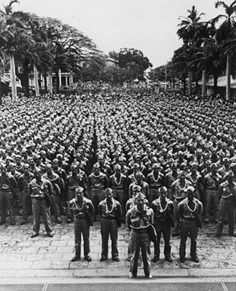 442nd RCT fight song excerpt, the version provided by 442nd Veterans Club, sung to the tune of the US Coast Guard anthem, lyrics by: Martin Kida, KIA
442nd RCT fight song excerpt, the version provided by 442nd Veterans Club, sung to the tune of the US Coast Guard anthem, lyrics by: Martin Kida, KIA
"All hail, all hail our combat team: the finest in the land.
Thru storm or rain, in peace or war for freedom, we shall stand.
We come from far-off Aloha Land: The Land of Paradise.
Hawai'i, Hawai'i: Pacific paradise.
Hawai'i, Hawai'i: Pacific paradise.
Four Forty-Second Infantry: We're the boys from Hawai'i nei.
We're fighting for you and the red, white, and blue.
We're going to the front and back to Honolulu-lulu.
Fight for dear ol' Uncle Sam.
Go For Broke, we don't give a damn.
Let them come and run at the point of our gun:
For freedom must be won.
I lai-lai (I lai-ai lai)
I lai-lai (I lai-ai lai)
I lai-lai lai-ai, lai la-lai-lai lai)
I lai-lai (I lai-ai lai)
I lai-lai (I lai-ai lai)…"
Training at Camp Shelby that began in 1943 ended in April 1944, and by June, they were in Italy against German positions in Tuscany. In September of that year, the 442nd participated in liberating southern France, having fought alongside the African American 92nd Infantry Division, driving Germans out of northern Italy, toward the Arno River, in the areas of Belvedere, Sassetta, Cecina, and Castellina Marittima (Hill 140 "Little Cassino") advancing a distance of only 40 costly miles. By the time they crossed the Arno, they’d suffered 17 missing, 44 non-combat injuries, 972 WIA, and 239 KIA. In late October, their anti-tank detachment rejoined the unit during a battle to find 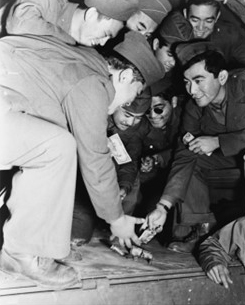 and liberate the "Lost Battalion." After leaving Naples, the 442nd landed at Marseille, having moved 500 miles on foot and by train through the Rhone Valley into position for the assault on Bruyeres and the Vosges Mountain range, with battle results going back and forth between opposing forces, taking and retaking of objectives, being called into action at Biffontaine, engaging in house-to-house warfare and tactics for nine days before they came to attempt the rescue of the "lost" 141st Alamo Regiment which had been cut off behind enemy lines, in the heaviest fighting the 442nd had seen. The valor of Nisei charging German emplacements beyond the breaking of enemy defenses, all the way to Saint-Die, undergoing tremendous losses on both sides, remains among the most memorable combined land forces assaults in US Army history. The regiment then headed to the Maritime Alps of the Riviera, patrolling a 14-mile segment of the French-Italian border with comparatively incidental casualties.
and liberate the "Lost Battalion." After leaving Naples, the 442nd landed at Marseille, having moved 500 miles on foot and by train through the Rhone Valley into position for the assault on Bruyeres and the Vosges Mountain range, with battle results going back and forth between opposing forces, taking and retaking of objectives, being called into action at Biffontaine, engaging in house-to-house warfare and tactics for nine days before they came to attempt the rescue of the "lost" 141st Alamo Regiment which had been cut off behind enemy lines, in the heaviest fighting the 442nd had seen. The valor of Nisei charging German emplacements beyond the breaking of enemy defenses, all the way to Saint-Die, undergoing tremendous losses on both sides, remains among the most memorable combined land forces assaults in US Army history. The regiment then headed to the Maritime Alps of the Riviera, patrolling a 14-mile segment of the French-Italian border with comparatively incidental casualties.
The last German defense in Italy against the hard-driving Nisei was Monte Nebbione, south of Aulia. The unit’s final push in April finally took that objective and Mount Carbolo. Following the fall of San Terenzo, the 2nd Battalion and Task Force Fukuda pincered to cut off a German retreat there, resulting in enemy surrender by the hundreds and thousands to our Fifth and Eighth Armies. This was the final action of the 442nd in the ETO of World War II, which ended on May 2.
Over 33,000 Japanese-Americans served in the U.S. Military during WWII, with more than 800 giving their lives for their country; ultimately, about 18,000 served with the 442nd IR/RCT over the full course of its formation. In less than two years of battle, members of the unit received 4,000 purple hearts, 560 Silver Stars, 52 DSCs, a DSM, 15 Soldier’s Medals, 4,000 Bronze Stars, and 21 MOHs. The unit itself was awarded seven, five in one month, PUCs and the Congressional Gold Medal in 2010 to the RCT. In 2012 all surviving members were made chevaliers of the French Legion d’Honneur. In total, members of the 442nd received 18,143 awards during their relatively brief time. April 5 is celebrated as National "Go For Broke Day." The venerable Representative and Senator Daniel Inouye of Hawaii is counted among its outstanding alumni. It has been stated that the 100th/442nd RCT is the most decorated unit for its size and duration of service in our history.
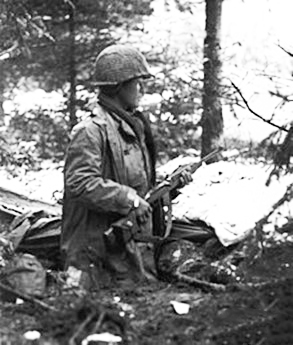 Despite their heroism and sacrifice, these soldiers, and by inference, their ancestors, experienced humiliations that were in no way deserved. Two incidents must be reported if only to demonstrate how far beyond those dark times America has evolved in the 80 years since then:
Despite their heroism and sacrifice, these soldiers, and by inference, their ancestors, experienced humiliations that were in no way deserved. Two incidents must be reported if only to demonstrate how far beyond those dark times America has evolved in the 80 years since then:
- In 1946, the American Legion refused to allow Nisei veterans into their ranks and removed them from the Honor Rolls. White officers of the 100th/442nd intervened, and gradually those names were restored.
- The General Dahlquist episode late in the war is remembered. In mid-November, as Division Commander, he ordered the 442nd to stand in formation for recognition and awards. Of the four hundred troops originally assigned, only eighteen survivors of K Co. and eight of I Co. turned out. The General lost his composure and demanded of Col. Virgil Miller, "I want all your men to stand for this formation." To which the Colonel replied, "That’s all of K company left, sir." The Commander had been regarded as one who treated these soldiers as cannon fodder. "Sometime later, while the former Commander of the 1st Battalion, Lieutenant Colonel Gordon Singles, was filling the role of Brigadier General at Fort Bragg (North Carolina), General Dahlquist arrived as part of a review. When he recognized Colonel Singles, he approached him and offered the Colonel his hand, saying, ‘Let bygones be bygones. It's all water under the bridge, isn't it?’ In the presence of the entire III Corps, Colonel Singles continued to salute General Dahlquist but refused to take Dahlquist's hand."
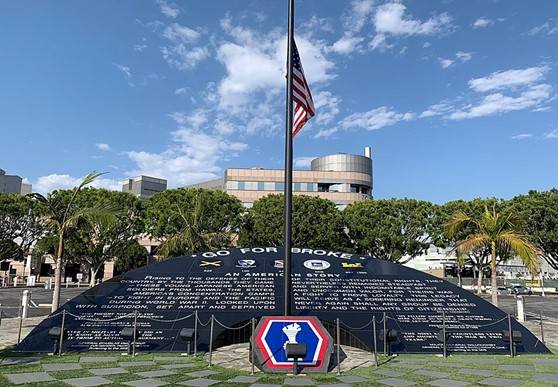 The 442nd was inactivated in 1946, reactivated in 1947 to the Reserves, and mobilized again in 1968 during the Vietnam War, carrying on the unit’s traditions and honors as the only ground combat unit of the U.S. Army Reserve and headquartered at Fort Shafter, Hawaii with two companies detached in American Samoa. Part of the unit was mobilized for duty during OIF at Balad, Iraq, between 2004-08, receiving the MUC for their actions and losing five more KIA in the ranks. In 2009 it was deployed once more as an element of the 29th Inf Brigade Combat Team to Kuwait, suffering two more losses. During this assignment, several dozen of the unit’s Samoan troops became naturalized U.S. Citizens.
The 442nd was inactivated in 1946, reactivated in 1947 to the Reserves, and mobilized again in 1968 during the Vietnam War, carrying on the unit’s traditions and honors as the only ground combat unit of the U.S. Army Reserve and headquartered at Fort Shafter, Hawaii with two companies detached in American Samoa. Part of the unit was mobilized for duty during OIF at Balad, Iraq, between 2004-08, receiving the MUC for their actions and losing five more KIA in the ranks. In 2009 it was deployed once more as an element of the 29th Inf Brigade Combat Team to Kuwait, suffering two more losses. During this assignment, several dozen of the unit’s Samoan troops became naturalized U.S. Citizens.
Between 1951 and 2018, six films were produced using "Go For Broke" in their titles, while fictional and documentary television series have featured its members. Among several books that have included extensive passages about the 442nd, James Michener’s "Hawaii" devotes a full chapter, not to mention the biographical and historical publications written and to be written. Commemorative monuments, such as the one in Los Angeles illustrated above, are dedicated to the 442nd here and abroad, as are specific highways in America and Europe. Asian Americans fought for both sides during our Civil War and every other war since that period. In 2023, the estimated number of living WWII 442nd veterans stands at about four hundred, most of whom live in Hawaii. These soldiers long ago earned their rightful place among the highest echelons of devotion and bravery known to the United States Army.